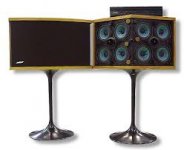I didn't find much info on this subject on diyaudio, so I thought I should ask.
Consider a sealed cabinet that uses a single driver, assuming it is full range. You sit 1 meter away, and you listen to the cabinet.
Take another cabinet that has roughly twice the liters (or the same liters, even better), and occupies 4 same drivers as the above driver. You sit 1 meter away, and you listen to the new cabinet.
My question is, how much will the frequency response alter?
I assume that more drivers means greater movement capability, so I think bass will be more huge. But what about middle range and high range frequencies?
I feel there could be spots that wave cancellation can occur, and since frequencies of above 400 Hz have a wavelenght of less than 1 meter, it could be possible that using multiple drivers could have an effect on the frequency response regarding middle and high frequencies.
Of course, I may be terribly mistaken, but I haven't really understood this. Use of multiple identical drivers is of course prominent in guitar cabinets, but I haven't had the opportunity to hear two cabinets that have one driver and 4 respectively, to make any judgements...
Consider a sealed cabinet that uses a single driver, assuming it is full range. You sit 1 meter away, and you listen to the cabinet.
Take another cabinet that has roughly twice the liters (or the same liters, even better), and occupies 4 same drivers as the above driver. You sit 1 meter away, and you listen to the new cabinet.
My question is, how much will the frequency response alter?
I assume that more drivers means greater movement capability, so I think bass will be more huge. But what about middle range and high range frequencies?
I feel there could be spots that wave cancellation can occur, and since frequencies of above 400 Hz have a wavelenght of less than 1 meter, it could be possible that using multiple drivers could have an effect on the frequency response regarding middle and high frequencies.
Of course, I may be terribly mistaken, but I haven't really understood this. Use of multiple identical drivers is of course prominent in guitar cabinets, but I haven't had the opportunity to hear two cabinets that have one driver and 4 respectively, to make any judgements...
I didn't find much info on this subject on diyaudio, so I thought I should ask.
Consider a sealed cabinet that uses a single driver, assuming it is full range. You sit 1 meter away, and you listen to the cabinet.
Take another cabinet that has roughly twice the liters (or the same liters, even better), and occupies 4 same drivers as the above driver. You sit 1 meter away, and you listen to the new cabinet.
My question is, how much will the frequency response alter?
I assume that more drivers means greater movement capability, so I think bass will be more huge. But what about middle range and high range frequencies?
I feel there could be spots that wave cancellation can occur, and since frequencies of above 400 Hz have a wavelenght of less than 1 meter, it could be possible that using multiple drivers could have an effect on the frequency response regarding middle and high frequencies.
Of course, I may be terribly mistaken, but I haven't really understood this. Use of multiple identical drivers is of course prominent in guitar cabinets, but I haven't had the opportunity to hear two cabinets that have one driver and 4 respectively, to make any judgements...
You should ask line array loudspeakers builders.
http://www.diyaudio.com/forums/full...o-towers-25-driver-full-range-line-array.html
Here is a thread that talks about this.
http://www.diyaudio.com/forums/multi-way/45379-lobbing-what-laymans-terms.html
http://www.diyaudio.com/forums/multi-way/45379-lobbing-what-laymans-terms.html
In general from my observation, going 1 driver to two driver the peek got higher.
If you have too much midrange, it will go worse.
If you have too much midrange, it will go worse.
- Status
- Not open for further replies.

